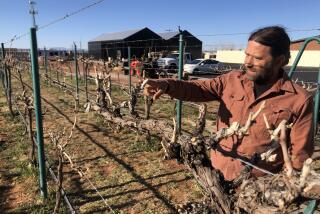Texas pleads for help as fires sear state
Beleaguered firefighters battling one of the most destructive Texas fire seasons on record found themselves punished not only by searing weather, but by lax brush clearance and dwindling budgets.
With no end in sight to scores of blazes — the largest had burned 785 homes and was only 30% contained Wednesday — fire officials pleaded for more equipment, and experts urged property owners to do a better job of protecting their homes.
“We needed resources yesterday,” Lt. Gov. David Dewhurst said, noting that he and Gov. Rick Perry — who was in California for a debate of GOP presidential contenders — were requesting that the federal government declare the state a major disaster area.
President Obama called Perry to assure the governor that requests for additional assistance would be quickly assessed, the White House said. Officials with the Federal Emergency Management Agency were in Texas preparing financial assessments to help pay the cost of fighting the fires.
It is unclear what the federal government’s share of the cost will be. In the last week, FEMA agreed to cover 75% of the expenses of fighting eight fires across the state.
The Texas Forest Service has been spending about $1.5 million a day on fighting the fires this week, agency spokesman Gary Lacox said. That does not include spending by local fire districts and volunteer fire departments.
As state officials scrambled to summon resources, the magnitude of the wildfires — at least 122 as of Wednesday — continued to overwhelm even the most experienced firefighters.
Officials in hard-hit Bastrop County were confident that firefighters would gain control of the state’s largest and most destructive blaze as winds ease and residents are allowed back into fire-ravaged neighborhoods, perhaps by week’s end. Some residents had done little to prepare for fire.
Ken Gold, a battalion chief from Denton, said residents in a subdivision burned by the Bastrop fire east of Austin had left homes blanketed in six-inch piles of pine needles as dry as matchsticks.
“They kind of let nature be nature,” Gold said. “It didn’t seem very fire-aware.”
The loss of one blue house particularly pained him.
It was a single-story, wood-frame home with a yard full of pine trees. He and his crew spent an hour scraping away pine needles and hosing down the area with water from an above-ground pool. Before he could finish, the fire snaked through the 30-foot-tall pine trees behind him.
“I was calling for help,” Gold said. “But everyone was busy somewhere else.”
Flames crept within a few feet of the crew.
“Then it got real hot real fast and we had to go,” Gold said.
About two hours later, he returned. There was nothing left but some propane tanks and the pool. All Gold could do was sit in the driveway and stare.
The Bastrop fire forced thousands of residents to evacuate and killed two people. Michael Farr, 48, who worked for Austin’s electrical department, was found dead at his home in Smithville. The other body was found several miles away and had not been identified late Wednesday.
Lake Travis Fire Rescue Chief Jim Linardos, a Redondo Beach native who worked for years in the North Lake Tahoe area, said Central Texas faced some of the same wildfire risks as California, but lacked the fire-prevention efforts and resources that help California firefighters immediately tackle blazes.
He wanted to add two engines to his five fire stations west of Austin this year, but instead was dealt a 12% budget cut.
“We needed air resources on this fire immediately,” Linardos said. “We had two helicopters we were sharing with other fires.”
They saved 300 homes, but lost 24.
He noted that Texas fire district funding is capped by the state at 10 cents per $100 valuation in property taxes. Linardos said that in Lake Tahoe, Nev., where he served as fire chief, he had five times the funding. State Sen. Kirk Watson, an Austin Democrat, has proposed doubling the state funding cap.
Volunteer fire departments, which cover much of the state, have also faced a 75% state budget cut this year under Perry and the Republican-controlled Legislature.
Lucy Nashed, a spokeswoman for the governor, said Perry had not taken a position on whether to increase the cap on funding fire districts. She defended the budget cuts to volunteer departments.
“We have given them the resources they need to respond,” she said.
When the Bastrop blaze erupted Sunday, residents relied on nine volunteer fire departments, each staffed by about 30 firefighters, some of whom ended up working 52 hours straight with no air support, said Mike Fisher, the county’s emergency management coordinator.
About 77% of the state’s fire departments are volunteer, and 86% of their firefighters help pay for their own equipment and gear, according to the State Firemen’s and Fire Marshals’ Assn. of Texas.
Lawmakers nearly doubled funding for volunteer departments to $25 million two years ago, then slashed it to $7 million this year.
“They weren’t about to say to the people ‘Let’s raise taxes.’ That’s their future voters,” said Chris Barron, the association’s executive director.
But even if firefighters were fully funded, they would still probably be overwhelmed by the latest spate of wildfires, said Carlton Britton, a retired professor of range management specializing in fire ecology at Texas Tech in Lubbock.
He said Texas officials needed to do more to encourage fire prevention, including clearing brush and making controlled burns in the state’s wooded suburbs.
“People think it’s beautiful; they just think they’re in tune with Mother Nature. And they are,” he said, “But Mother Nature is going to kick their butt.”
molly.hennessy-fiske@latimes.com
Times staff writer Brian Bennett in Washington contributed to this report.
More to Read
Start your day right
Sign up for Essential California for news, features and recommendations from the L.A. Times and beyond in your inbox six days a week.
You may occasionally receive promotional content from the Los Angeles Times.







